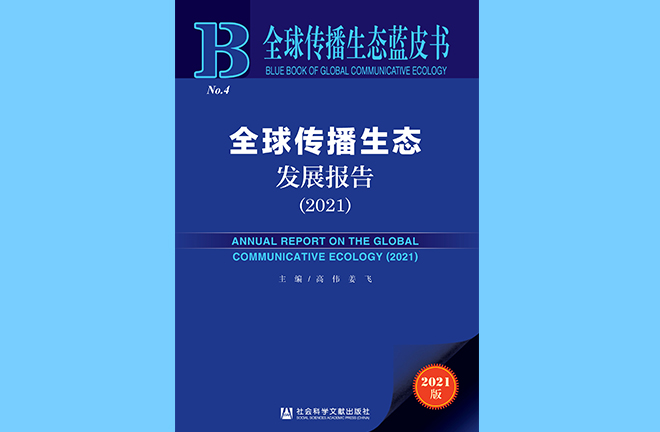Blue Book on global communication landscape released

FILE PHOTO: Cover of the Blue Book
Blue Book on Global Communication Ecology (2021) was released in Beijing on Feb. 28.
Gao Wei, editor-in-chief of the Blue Book and vice president of China Global Television Network Co., Ltd., said that the Blue Book focuses on the current global communication ecology, analyzes global communication hotspots, and predicts future trends in global communication, in the hope of making suggestions for media research and industry development.
The Blue Book outlines the development of world media and changes in the global communication landscape following 2020, and identifies six specific features. First, the audience’s audio-visual consumption has seen a more significant “online” trend. Second, the news industry has been hard hit by the “infodemic,” but the industry is also full of new opportunities. Third, “cloud” media exploration is more diverse, and new business formats have propelled information production into all aspects of consumption. Fourth, the media industry must reflect on its sustainable development, and the trend of communication’s integration with multiple fields is clearer. Fifth, technology has further empowered content production, dissemination, and distribution, and intelligent dissemination is now within reach. Sixth, information regulation is clearer, and power constraints and healthy development in the digital age have become important themes.
Jiang Fei, editor-in-chief of the Blue Book and dean of the School of International Journalism and Communication at Beijing Foreign Studies University, said that the global communication ecology has shown new characteristics. In terms of strategic layout, as countries have paid more attention to information dissemination infrastructure, 5G commercialization has been widely rolled out around the world, and the competition pattern of “picking sides” in the 6G field has taken an initial shape. In addition, competition in the field of satellite internet tends to be intensified.
At present, China’s international communication is in a critical period of opportunity, and both industry practice and academic research are facing major challenges, said Hu Zhengrong, director of the Institute of Journalism and Communication Studies at the Chinese Academy of Social Sciences. Understanding China’s international communication in the global communication ecology will bring great opportunities for academic research and practical innovation.
Looking to the future, the Blue Book conducts a forward-looking analysis of the development of the global communication ecology from four perspectives.
First, as the United States tries to slow China’s development in the digital field, this will trigger a de-globalization trend in the field of information dissemination infrastructure construction. Second, the application of technology in the media field is like a “Pandora’s box,” and more attention should be paid to the “disenchantment” of technology.
In addition, the children’s market and the “silver economy” have become new growth points and need more attention. Moreover, it is necessary to constantly pay close attention to changes in the global information dissemination pattern under the changing international political and economic landscape.
Analyzing the global news media industry’s development trend in 2022, Shi Anbin, deputy dean of the School of Journalism and Communication at Tsinghua University, noted that the global news and media industry will continue to explore new directions and approaches in an era characterized by fluidity, uncertainty, complexity, and ambiguity.
Edited by JIANG HONG
